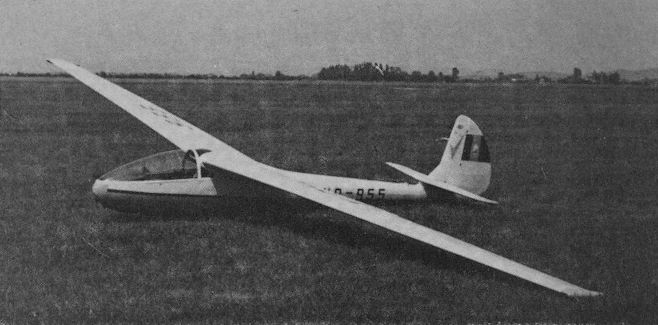
M.Hardy. Gliders & Sailplanes of the world
ICA-Brasov IS-3D
The ICA-Brasov or Intreprinderea de Constructii Aeronautice Brasov (Aircraft Construction Factory Brasov) is responsible for all sailplane development and production in Romania, and their principal designer is Professor Iosif Silimon, who has created a long series of sailplanes that are widely used in the national clubs; these are prefixed by the letters 'IS' which form the Professor's initials. Among the earliest of these was the IS-3D training or Standard Class single-seater, the prototype of which, the IS-3 Traian Vuia, was built in 1956 and which continued in production at Brasov until the early 1970s, being widely used in the Romanian clubs. This elegant design has a distinctive pointed top to the fin and rudder and is fitted with a drogue parachute for deployment in short-field landings. It is of conventional wooden construction with plywood and fabric covering, the single-spar high cantilever wings being plywood-covered from the leading edge to the spar and fabric covered aft of the spar to the trailing edge; there are air brakes in the wing upper and lower surfaces and wing tip 'salmon' fairings are fitted. The all-wood fuselage is of oval cross-section and the fin and tailplane are plywood-covered, the elevators and rudder being fabric covered; there is a Flettner-type trim tab in the starboard elevator. The landing gear consists of a fixed monowheel forward of the cg with a pneumatic tyre and mechanical brake, and a short nose skid and tailskid. The pilot sits under a large sideways-hinging cockpit canopy.
Data: IS-3D
Span: 50 ft 3 2/2 in
Length: 23 ft 9 1/2 in
Height: 5 ft 3 in
Wing area: 164.6 sqft
Aspect ratio: 15.30
Empty weight: 485 lb
Max weight: 754 lb
Max speed: 150 mph
Max aero-tow speed: 75 mph
Min sinking speed: 2.23 ft/sec at 40 mph
Best glide ratio: 28:1 at 46 mph
ICA-Brasov IS-8
This two-seater design was intended to fill the roles of training, solo flying and aerobatic flying and first flew in prototype form on 14 September 1960, duly going into service with the Romanian gliding clubs. The IS-8 is of very similar plywood- and fabric-covered wooden construction to the IS-3, and is characterised by cantilever shoulder wings with a distinctive 7° forward sweep at the 25% chord line,and with a rectangular centre section and tapered outer panels. The wings are all-wood single-spar structures with a leading edge torsion box, 70% fabric covered, and the slotted wooden ailerons are plywood- and fabric-covered. The fuselage is a metal and plywood monocoque and has an air brake on each side of it, instead of in the more usual wing-mounted position. The wooden tail unit is also ply- and fabric-covered and there is an unsprung non-retractable monowheel without a brake, and a rubber-mounted skid. The pilot and pupil sit in tandem under a moulded plastic canopy.
Data: IS-8
Span: 43 ft 9 1/2 in
Length: 24 ft 1 1/2 in
Wing area: 166.3 sqft
Aspect ratio: 11.5
Empty weight: 463 lb
Max weight: 882 lb
Max speed: 112 mph (in smooth air)
Max aero-tow speed: 74.5 mph
Min sinking speed: 3.22 ft/sec at 43.5 mph
Best glide ratio: 23:1 at 53 mph
- M.Hardy. Gliders & Sailplanes of the world
Фотографии
-
Jane's All the World Aircraft 1972 / 03 - Sailplanes
Регистрационный номер: YR-955 IS-3D single-seat training and Standard Class sailplane
-
Air Enthusiast 1998-03 / D.Vlad - Out of the Ashes
Регистрационный номер: YR-954 IS-3d YR-954 pole-mounted at Piatra Neamt. It was destroyed in the 1980s during a storm.
- Фотографии

